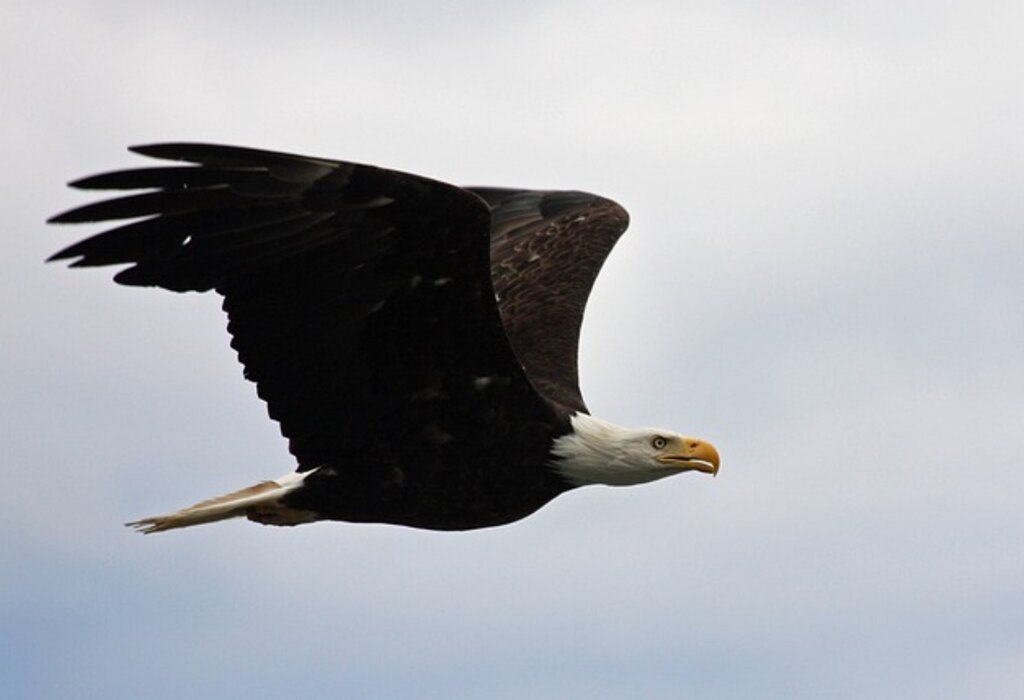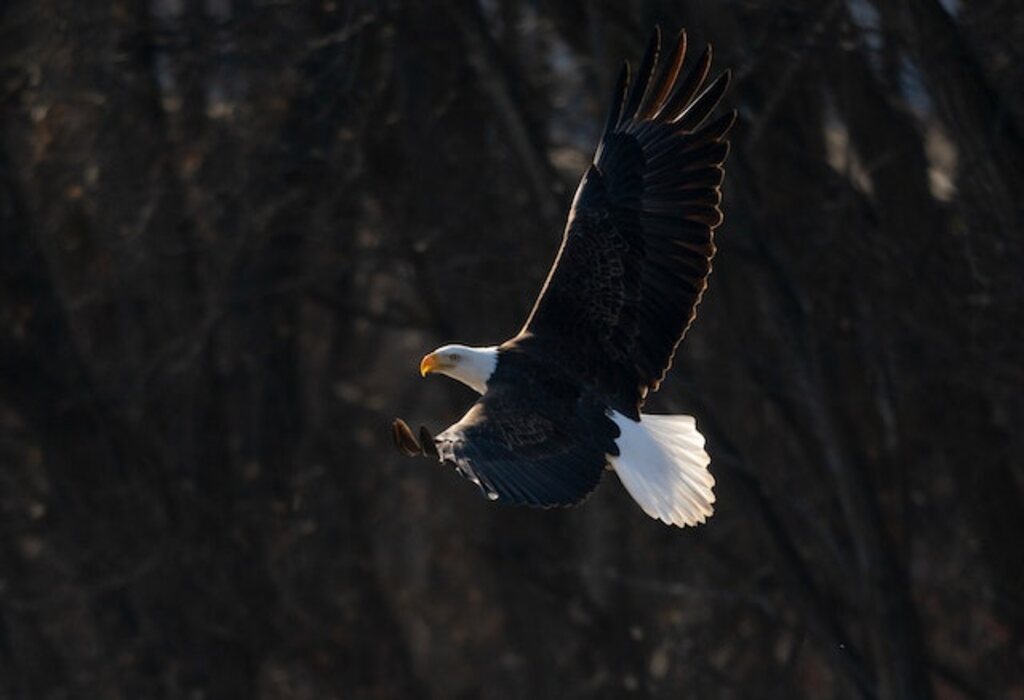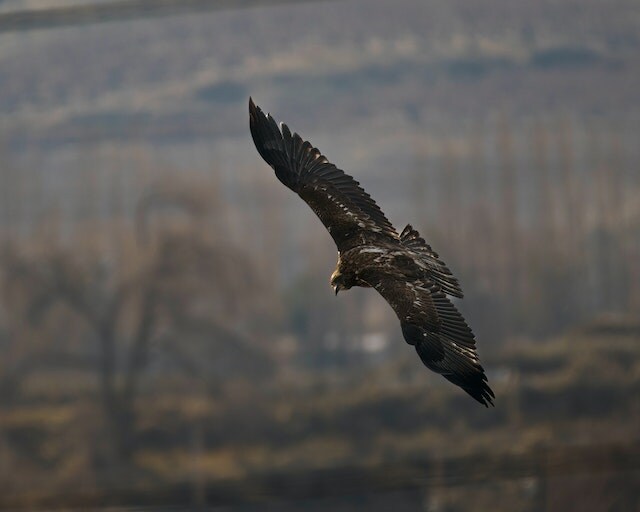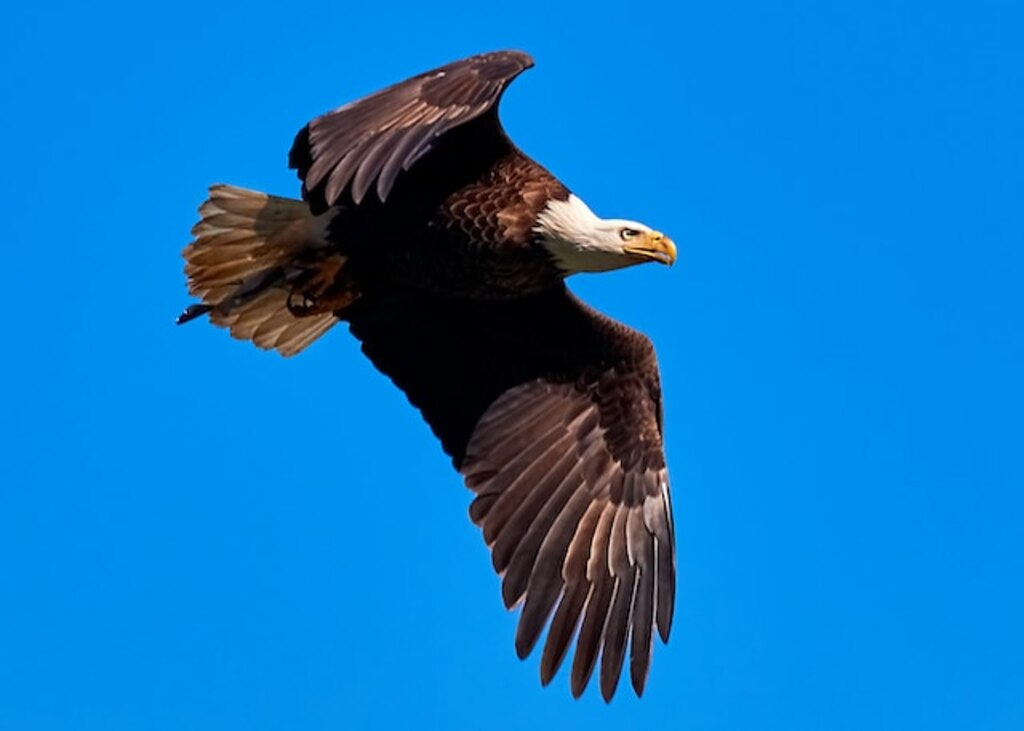In the realm of avian wonders, eagle migration stands as a breathtaking phenomenon. With wings outstretched, these majestic birds take to the skies, charting courses that span continents.
When do eagles migrate north? This article delves into their enigmatic rhythms, exploring the timing and routes of these extraordinary journeys.
We unlock the mysteries behind their migrations, discovering the remarkable resilience and adaptability of these regal fliers.
Join us on this captivating expedition to uncover the untold stories of eagle migration and bear witness to the epic journeys that define these magnificent birds’ existence.
Table of Contents
- 1 Key Takeaways
- 2 When Do Eagles Migrate North
- 3 Understanding Eagle Migration Patterns
- 4 The Instinctual Drive to Migrate
- 5 Timing of Eagle Migration
- 6 Geographic Routes of Eagle Migration
- 7 Factors Affecting Eagle Migration
- 8 The Importance of Stopover Sites
- 9 Conservation Challenges for Migrating Eagles
- 10 Tracking and Research Methods
- 11 Famous Eagle Migration Destinations
- 12 The Significance of Eagle Migration
- 13 How to Observe and Support Eagle Migration
- 14 Frequently Asked Questions
- 14.1 What is the average distance that eagles migrate north?
- 14.2 Are there specific times of the year when eagles migrate back south?
- 14.3 How long do eagles typically stay at stopover sites during migration?
- 14.4 What are some of the main threats that migrating eagles face?
- 14.5 Can regular birdwatchers contribute to eagle migration research and conservation efforts?
- 15 Author
Key Takeaways
- Eagles migrate north during the spring in search of breeding grounds and food sources.
- Migration timing is crucial for breeding and raising offspring.
- Factors affecting eagle migration include food availability, weather conditions, and breeding grounds.
- Conservation efforts are necessary to ensure the long-term viability of migrating eagle populations.
When Do Eagles Migrate North
Eagles typically migrate north during spring. As the weather warms and food becomes more abundant, eagles undertake their northward journey to their breeding grounds.
Migration timing can vary based on species and geographic location. Bald eagles, for instance, begin their migration in February and March, while some golden eagles start their journey as early as late winter.
Understanding Eagle Migration Patterns
Eagle migration towards the northern regions occurs during spring, as they navigate across vast landscapes and soar above majestic mountain ranges.
These majestic birds possess a remarkable instinctual behavior that drives them to undertake long and arduous journeys in search of suitable breeding grounds and abundant food sources.
The migratory patterns of eagles are influenced by a combination of environmental factors, including temperature, food availability, and daylight hours.
As the days grow longer and the temperatures rise, eagles sense the changing conditions and embark on their northward migrations.
They utilize thermal updrafts and prevailing wind patterns to conserve energy and cover long distances.
This instinctual drive to migrate is deeply ingrained in their DNA and has been honed over generations through a process of natural selection.
Transitioning to the subsequent section, this innate behavior underscores the fascinating nature of eagle migration.
The Instinctual Drive to Migrate
Driven by an innate instinct, these majestic birds embark on a remarkable journey every year towards their breeding grounds in the northern regions.
Eagle migration is a phenomenon shaped by evolutionary reasons and governed by intricate migration patterns. To better understand this awe-inspiring behavior, consider the following facts:
- Genetic Programming: Eagles possess a genetic predisposition that compels them to migrate. This programming ensures their survival and maximizes their reproductive success.
- Seasonal Changes: The timing of eagle migration is closely tied to the changing seasons. As temperatures drop and food availability decreases in their current habitat, eagles are driven to seek more favorable conditions in the north.
- Breeding Grounds: The northern regions provide ideal nesting sites and abundant food sources, which are essential for successful breeding and raising offspring.
- Navigation Skills: Eagles possess exceptional navigational abilities, relying on cues such as magnetic fields, celestial landmarks, and visual landmarks to navigate their migratory routes.
Understanding the evolutionary reasons and migration patterns behind eagle migration provides valuable insights into their behavior and ecological significance.
Transitioning to the subsequent section about the timing of eagle migration, it becomes evident that their journey is intricately timed to optimize their chances of success.
Timing of Eagle Migration
The annual journey of these majestic birds is intricately timed to coincide with the optimal conditions for breeding and raising offspring.
Understanding the timing of eagle migration is crucial for conservation efforts and for gaining insights into their remarkable migratory patterns.
Eagles typically migrate north in the spring, when food sources become more abundant and temperatures become milder.
They take advantage of the rising warm air currents, known as thermals, to conserve energy during their long-distance flights.
The timing of migration is also influenced by the availability of nesting sites and the need to establish territories before breeding.
By studying the timing of eagle migration, scientists can better understand the factors that drive their movements and develop strategies to protect their habitats.
Transitioning into the next section about the geographic routes of eagle migration, it is fascinating to explore the paths these birds take on their annual journey.
Geographic Routes of Eagle Migration
One intriguing aspect of eagle migration is the exploration of the diverse and intricate paths these majestic birds take on their annual journey.
Eagles migrate north along specific geographic routes, which vary depending on their breeding grounds and wintering areas.
Some eagles migrate along the coasts, following the shoreline and taking advantage of updrafts and thermals. Others migrate inland, navigating across mountains, valleys, and rivers.
The timing of eagle migration also varies, with some birds starting their journey as early as February, while others begin in March or April.
This variation in migration timing is influenced by factors such as weather conditions, food availability, and breeding patterns.
Understanding the geographic routes and migration timing of eagles is crucial for conservation efforts and for ensuring the survival of these magnificent birds.
Transitioning to the subsequent section about factors affecting eagle migration, it is important to consider the various environmental and biological factors that influence their annual journey.
Factors Affecting Eagle Migration
Influenced by a multitude of factors, the annual journey of eagles is a delicate dance between survival and adaptation, as they navigate diverse landscapes and overcome numerous obstacles.
This instinctual drive to migrate north is guided by a combination of environmental cues and internal factors.
The factors affecting eagle migration include:
- Food availability: Eagles migrate to areas where food is abundant, such as lakes and rivers teeming with fish or open grasslands with ample prey.
- Weather conditions: Eagles are sensitive to weather patterns, and favorable winds can assist their long-distance flights, while adverse weather can delay or alter their migration routes.
- Breeding grounds: Eagles migrate to specific areas for breeding and nesting, where they can find suitable mates and establish territories.
These factors collectively shape the timing and routes of eagle migration, highlighting the intricate balance between biological imperatives and external circumstances. Understanding these influences is crucial for conserving and managing eagle populations.
Transitioning to the subsequent section, the importance of stopover sites becomes apparent as eagles seek temporary respite during their arduous journey.
The Importance of Stopover Sites
As eagles undertake their annual migration, the presence of stopover sites plays a critical role in their long and arduous journey.
Stopover sites are essential resting and refueling points for eagles during their migration, providing them with necessary resources to continue their journey.
These sites serve as oases amidst vast expanses of land, offering abundant food sources and suitable habitats for resting and socializing.
Conservation efforts aimed at protecting and preserving these stopover sites are crucial for the survival of migrating eagles.
By ensuring the availability of these essential resources, conservationists contribute to the successful completion of the migration cycle and the overall population health of eagles.
However, despite the importance of stopover sites, conservation challenges for migrating eagles persist, threatening the sustainability of their annual journeys.
Conservation Challenges for Migrating Eagles
Conservation challenges facing migrating eagles include the loss of critical stopover sites, with estimates indicating that approximately 50% of these sites have been degraded or destroyed due to human activities.
This loss of habitat poses a significant threat to the survival of migrating eagle populations.
Conservation efforts are crucial to mitigate the population decline and ensure the long-term viability of these majestic birds.
The challenges faced by migrating eagles in their journey north are numerous. These challenges include:
- Habitat destruction: Urbanization and industrial development have led to the destruction of important stopover sites, depriving eagles of essential resting and feeding areas.
- Pollution: Chemical pollutants and contaminants in water bodies along migration routes can have detrimental effects on eagles and their prey, leading to population decline.
- Collisions: Eagles are at risk of colliding with man-made structures such as power lines and wind turbines, resulting in injury or death.
- Climate change: Alteration of weather patterns and loss of suitable habitats due to climate change can disrupt migration routes and affect the availability of food sources.
To address these conservation challenges, tracking and research methods are employed to gather data on eagle movements and behaviors.
Tracking and Research Methods
Tracking and research methods play a crucial role in understanding the movement patterns and behaviors of migrating eagles, providing valuable insights for conservation efforts.
Researchers utilize various techniques to track eagle migration, including satellite telemetry, radio telemetry, and wing tagging.
Satellite telemetry involves attaching small transmitters to eagles, which transmit location data to satellites, allowing researchers to track their movements in real-time.
Radio telemetry involves attaching radio transmitters to eagles and using specialized receivers to track their signals.
Wing tagging involves attaching numbered tags to the wings of eagles, which can be read from a distance using binoculars or telescopes.
These tracking methods enable researchers to gather data on migration routes, stopover locations, and migration timing, contributing to our understanding of eagle populations and guiding conservation initiatives.
Transitioning to the subsequent section, famous eagle migration destinations highlight the importance of these tracking and research methods in studying and protecting these magnificent birds.
Famous Eagle Migration Destinations
This discussion will focus on two famous eagle migration destinations:
Hawk Mountain Sanctuary in Pennsylvania is known as the world’s first refuge for birds of prey and is a renowned destination for eagle watching during migration season.
The Chilkat Bald Eagle Preserve, situated in the Alaska Panhandle, is home to one of the largest gatherings of bald eagles in the world, attracting thousands of these majestic birds during the winter months.
Both locations offer unique opportunities for scientists and bird enthusiasts to observe and study the behavior and ecology of eagles during their migration.
Hawk Mountain Sanctuary, Pennsylvania
Hawk Mountain Sanctuary in Pennsylvania is a renowned destination for bird enthusiasts due to its strategic location along a major migratory route, making it an ideal spot to observe the northward migration of eagles.
This sanctuary is famous for its annual hawk migration, which attracts thousands of visitors each year. Here are five reasons why Hawk Mountain Sanctuary is a must-visit destination for bird watchers:
- Spectacular Views: The sanctuary offers breathtaking views of the surrounding mountains, providing a picturesque backdrop for observing the majestic eagles in flight.
- Diverse Bird Species: Besides eagles, Hawk Mountain Sanctuary is home to a wide variety of bird species, including hawks, falcons, and vultures, making it a paradise for bird lovers.
- Research and Education: The sanctuary is dedicated to scientific research and conservation efforts, allowing visitors to learn about the fascinating world of birds and their migratory patterns.
- Hiking Trails: The sanctuary boasts numerous well-maintained hiking trails, providing visitors with the opportunity to explore the beautiful natural surroundings while spotting birds along the way.
- Visitor Center: The sanctuary’s visitor center offers informative exhibits, educational programs, and expert staff who can provide guidance and answer questions about the sanctuary’s wildlife.
Transitioning to the subsequent section about the Chilkat Bald Eagle Preserve in Alaska, this iconic sanctuary offers another exceptional destination for witnessing the grandeur of eagle migrations.
Chilkat Bald Eagle Preserve, Alaska
The Chilkat Bald Eagle Preserve in Alaska is renowned for its significant role in the migration patterns of eagles.
Located in the northern region of the state, this preserve acts as a vital habitat for numerous eagle species during their migratory journey.
The preserve encompasses a diverse range of habitats, including rivers, forests, and estuaries, providing an abundance of food sources for the eagles.
One of the most noteworthy features of the Chilkat Bald Eagle Preserve is the congregation of eagles that occurs during the fall and winter months.
This phenomenon attracts hundreds of eagles from different parts of North America, creating a spectacular sight for visitors and researchers alike.
By studying the eagle migration patterns in this preserve, scientists can gain valuable insights into the behavior and ecology of these majestic birds.
Transitioning into the subsequent section, the significance of eagle migration becomes evident when considering their crucial role in maintaining ecosystem balance.
The Significance of Eagle Migration
Eagle migration holds great ecological significance as it plays a crucial role in maintaining the balance of ecosystems and food webs.
Eagles are top predators in their habitats, and their movement between different regions helps regulate population levels of prey species and control the distribution of energy and nutrients.
Additionally, eagle migration holds cultural and symbolic importance in many societies around the world.
These majestic birds have been revered for centuries, symbolizing strength, freedom, and power, and their annual migration serves as a powerful reminder of the cyclical nature of life and the interconnectedness of humans and nature.
Ecological Role and Food Web Connections
Ecological role and food web connections are fundamental aspects that contribute to the migration patterns of eagles.
Eagles play a significant ecological impact in their respective habitats, as they are apex predators that help regulate the population of their prey species.
Their migration allows them to follow the seasonal availability of food resources, such as fish, small mammals, and birds.
This predator-prey dynamic is crucial for maintaining the balance and health of the ecosystems they inhabit.
Additionally, the migration of eagles creates intricate food web connections, as they interact with other species during their journey.
For example, they may compete with other predators or scavenge on carcasses left by larger carnivores. These interactions shape the distribution and abundance of species within the ecosystem.
Understanding the ecological role and food web connections of eagles provides valuable insights into the functioning of ecosystems and the interconnectedness of species.
This knowledge can inform conservation efforts and ecosystem management strategies.
Transitioning to the next section, the cultural and symbolic importance of eagle migration is also significant.
Cultural and Symbolic Importance
Cultural and symbolic interpretations of eagle migration provide a rich tapestry of meaning and significance across diverse human societies.
Eagles have long held cultural significance for many indigenous communities, serving as powerful symbols of strength, freedom, and spirituality.
In Native American cultures, the eagle is often seen as a messenger between humans and the divine, representing wisdom and guidance.
The cultural importance of eagle migration is reflected in various rituals, ceremonies, and art forms, such as dances and totem poles.
Moreover, eagles are frequently depicted in flags, national emblems, and currency, symbolizing national pride and identity.
Understanding the cultural and symbolic representation of eagle migration enhances our appreciation for these majestic birds and fosters a deeper connection with nature.
Transitioning into the subsequent section about how to observe and support eagle migration, it is crucial to acknowledge the significance of these practices in preserving and protecting this awe-inspiring phenomenon.
How to Observe and Support Eagle Migration
During the awe-inspiring spectacle of eagle migration, one can enhance their observation and contribution by employing various strategies.
To effectively observe eagle migration, individuals can utilize specific observing techniques. This may include finding a prime location with a clear view of the sky and the eagles’ flight path.
Additionally, using binoculars or a spotting scope can provide a closer look at the eagles as they soar through the air.
Another way to support eagle migration is by participating in citizen science initiatives.
These initiatives allow individuals to contribute valuable data that can help researchers track and monitor eagle populations and migration patterns.
By following established protocols and submitting observations, individuals can actively contribute to the scientific understanding of eagle migration and aid in the conservation efforts of these majestic birds.
Frequently Asked Questions
What is the average distance that eagles migrate north?
The average distance that eagles migrate north varies depending on the species and individual bird. Migration patterns are influenced by factors such as food availability and breeding grounds, and can range from a few hundred to several thousand kilometers.
Are there specific times of the year when eagles migrate back south?
Eagle migration patterns are influenced by various factors, including seasonal changes, availability of food, and breeding behaviors. Specific times of the year when eagles migrate back south vary depending on these factors.
How long do eagles typically stay at stopover sites during migration?
Eagle migration patterns vary in duration at stopover sites due to environmental factors. Factors such as availability of food, weather conditions, and ecological resources influence the length of time eagles typically stay at these sites during migration.
What are some of the main threats that migrating eagles face?
Migrating eagles face several threats, including habitat loss, illegal hunting, electrocution from power lines, and collisions with wind turbines. These threats, combined with the impact of climate change, highlight the importance of conservation efforts to protect eagle populations.
Can regular birdwatchers contribute to eagle migration research and conservation efforts?
Birdwatcher involvement in eagle migration research and conservation efforts is crucial. Data collection methods, such as citizen science projects and observation networks, allow regular birdwatchers to contribute valuable data for monitoring and understanding eagle migration patterns and threats.








